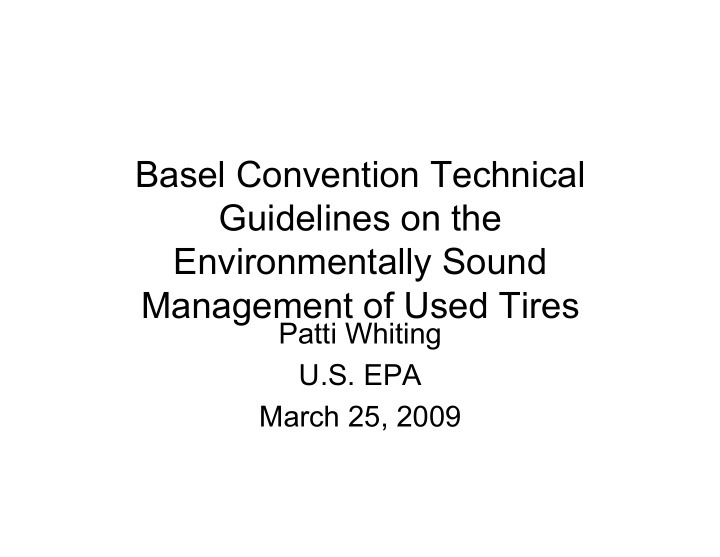



Basel Convention Technical Guidelines on the Environmentally Sound Management of Used Tires Patti Whiting U.S. EPA March 25, 2009
Basel Convention Background • The Basel Convention is a multi-lateral environmental agreement (treaty) governing the transboundary movement of hazardous waste – the Convention established a “prior informed consent” system to control the import and export of Basel hazardous waste. • This Convention was negotiated under the auspices of the UNEP in the late 1980s; was adopted in 1989 and entered into force in 1992. • There are over 170 Parties to the Basel Convention. Canada and Mexico are both Parties to the Convention. The U.S. is not a Party. – Every U.S. Administration has been in favor of ratification, however, we have been unable to get implementing legislation in place to enable ratification.
Environmentally Sound Management • A cornerstone of the Basel Convention is the concept of environmentally sound management (ESM). – the Basel Convention defines ESM as taking all practical steps to ensure that hazardous wastes and other wastes are managed in a manner which will protect human health and the environment against the adverse effects which may result from such wastes – parties are expected to manage and dispose of wastes in an ESM manner – a number of technical guidelines have been developed by technical working groups implementing the Convention, addressing the environmentally sound management of specific wastes or waste management processes – Basel also encourages Parties to minimize the quantities that are moved across borders, and to treat and dispose of wastes as close as possible to the place of generation
What is waste under the Basel Convention? • Annex I lists categories of wastes to be controlled. Annex III lists hazardous characteristics. Annexes VIII and IX further clarified Annexes 1 and III and list those wastes that are classified as hazardous and subject to the control procedures under the Convention • Parties may also identify wastes other than those listed in the Convention as hazardous waste, for the purposes of the Basel Convention, under their national legislation. • Annex II of the Convention identifies “other wastes” (essentially household wastes) that require special consideration under the Convention
Scope of the Convention • Annex IV defines disposal operations that are covered by the Convention – Annex IV of the Convention defines “disposal” as including operations resulting in final disposal (IVA) and operations which may lead to resource recovery, recycling reclamation, direct re- use or alternative use (IVB) – although specific reuse operations are not expressly listed in under IVB, there is some disagreement as to whether reused materials (such as end-of-life electronics and used tires) are considered Basel hazardous wastes.
The Basel Convention in the 21 st Century • Since the Basel Convention was drafted 20 years ago, a number of factors have changed. – Economies have become more global in nature and there is increasing trade inter-dependence between governments for material inputs and products; – Newer, non-traditional waste streams, such as end-of- life electronics and ships, have emerged-waste streams that were not contemplated when the Convention was drafted in the late 1980’s – Within this context, issues of implementation of the Convention have arisen with regards to recycling, refurbishment and reuse.
Brazil has Played a Prominent Role with Regards to Used Tires • During the Eight Conference of the Basel Parties, a decision was made to revise existing Technical Guidelines on the ESM of Used Tires • Brazil volunteered to lead the technical workgroup • This process has had political undertones due trade issues associated with used tires.
World Trade Organization Used Tires Dispute • A few years ago, the European Communities initiated a World Trade Organization (WTO) dispute against Brazil for its action to prohibit imports of retreaded tires. • The Brazilian government argued that “the import of used and retreaded tires increases the volume of waste and environmental liabilities of the country” and that they had more than they can handle, employing non-combustion techniques. • The WTO arbitral panel ruled that Brazil’s ban violated the GATT, as Brazil was not enforcing a parallel ban on the import of used tires for use by its domestic retreading industry. Many NGOs argued that this ruling set a dangerous precedent, and that a country’s sovereign right to protect the environment and public health should not be overruled by trade interests. However, the Panel accepted Brazil’s contention that the ban was “necessary to protect human, animal or plant life or health”.
Used Tires ESM Guidelines • The process of revising the Used Tires ESM Guidelines has highlighted some of the challenges associated with implementing the Convention within the context of a shifting paradigm from disposal to recycling and reuse. • The U.S. maintains that Basel should limit its focus to hazardous waste disposal and recycling, and not expand its mandate into the reuse of products.
Recommend
More recommend